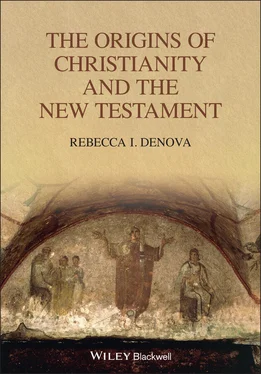What is deemed the “first quest” saw the production of popular books under the category of the Lives of Jesus , applying the new historical methods in the eighteenth and nineteenth centuries. The writers freely filled in details (e.g. his life as a carpenter), harmonized the differences among the gospels, and psychoanalyzed Jesus (“What was he thinking at various times?”). New literary approaches to understanding “myth” in the ancient world led a few writers to totally dismiss the miracle stories and supernatural elements of Jesus as “myth.” Each writer began with an overall portrait of Jesus (as a reformer, as a revolutionary) and anything that did not fit into this portrait was eliminated.
Albert Schweitzer (1875–1965)
Albert Schweitzer was a German theologian and doctor (the latter part of his life was spent as a missionary in Gabon, Africa). In 1906 he published The Quest for the Historical Jesus , largely a critique against Lives of Jesus , but he also provided new tools for the “quest” through the rest of the century.
A significant omission in the Lives according to Schweitzer was the “ apocalypticJesus.” In the gospels, Jesus had proclaimed the imminence of God’s “kingdom” on earth. This was the Prophetic claim that God would intervene in history one more time in “the final days.” But the “kingdom” did not arrive. Was Jesus wrong?
Over the centuries, the delay of the kingdom was rationalized as time passed; Christians still awaited the kingdom, but in the interim, the church became idealized as a form of the kingdom on earth until Jesus returned. The problem of Jesus as a failed prophet became buried as somewhat embarrassing. The focus was more on elucidating Christian dogma. Schweitzer claimed that analysis of the “apocalyptic Jesus” should be the starting point for historical exploration, in the context of various views of apocalyptic thinking by Jews in the first century. This portrait of Jesus became a template for research in the rest of the nineteenth century. The importance of understanding apocalyptic thinking by Jews in the first century is now a fundamental element of research for New Testament scholars.
Ernest Kasemann (1906–1998) is credited with arguing that it was possible to uncover the historical Jesus through the application of new analytical tools, which became known as the period of the “second quest.” By the 1950s, scholars began to recognize that the first gospel, Mark, was written approximately forty years after the death of Jesus. The others followed Mark, often adapting and editing the first gospel as well as adding new material ( Figure I.1). How do we distinguish the “sayings” of Jesus from those of Mark and the others?
Figure I.1 Timeline for events and the writing of the gospels.
| BCE |
|
| Matthew’s nativity |
6 BCE |
| Death of Herod the Great |
4 BCE |
|
0 |
| Luke’s nativity |
6 CE |
| The ministry of Jesus; the reign of Pontius Pilate |
26–36 |
| The letters of Paul |
50s–60s |
| The Jewish revolt against Rome |
66–73 |
| Mark’s gospel; the Roman destruction of Jerusalem and the Temple |
69/70 |
| Matthew’s gospel |
85? |
| Luke’s gospel; Acts of the Apostles |
95? |
| John’s gospel |
100? |
Jesus, as far as we know, never wrote anything down. Nor, contrary to popular belief, did his disciples write anything down. The gospels were not written by anyone in Jesus’s immediate circle . When Jesus “called” these were mostly Galilean fishermen. What were the odds that they could write Greek? (We examine speculation on the writer of each gospel in the individual chapters.)
In relation to the historical events concerning the ministry and death of Jesus, we have no contemporary eyewitness evidence for those events . There are no Jewish records or Roman records. This is incredibly significant. And it takes a while to think about. Because the events in the life of Jesus are so central to Christianity, most moderns assume that “the whole world was watching.” This is particularly true when it comes to the crucifixion of Jesus. But there is no reason why this crucifixion would be noted, as Rome crucified thousands of Jews. This crucifixion was devastating to his immediate circle, but most other Jews would see him as just one more victim of Roman oppression.
The earliest historical “evidence” that we have concerning a movement centered on the teachings of Jesus is found in the letters of Paul, written between 50 and 60 ce. Again, it is difficult to rely on this material for details of the ministry because Paul himself was not a witness to events. He never met Jesus of Nazareth. Paul began his missions twenty to twenty-five years after the death of Jesus, but, as we will see, Paul was not interested in the “historical Jesus.” Paul’s central focus was on “the resurrected Christ” ( Christosin Greek for the Hebrew term, “ messiah”).
The gospels of the New Testament have no internal dates. There are no clues (such as definite events or known individuals) for us to precisely date them to the time of their writing. The complication is that they are all writing a story that occurred between roughly 26 and 36 ce, but from their point of view decades later .
To uncover the “ logia ” (the “words” of Jesus) and events reported in Mark, Kasemann’s work evolved into a series of “tests” that could be applied to the material:
Language The four gospels are written in Greek (the common language for government, education, and trade in the Eastern Empire). However, the tradition was that Jesus spoke Aramaic, a Semitic language from Syria that arose in the sixth century bce. It was adopted by Jews in the region of the Galilee and parts of Judea after the period known as “the Exile.” It shares many loan words with Hebrew and was also written in a form of Hebrew script.To determine if a saying of Jesus was original, scholars translated the Greek text of Mark into Aramaic. If it “worked,” meaning not just a word-for-word translation, but grammatically, syntax, etc., it did not prove that Jesus said it, but went into a pile as “perhaps.” On the other hand, if it could not be translated correctly, it was thrown out.Some scholars have now challenged this criterion as archaeology continues to provide more information on the region. Towns and cities in the first century were “mixed,” meaning that Jews and Gentiles lived side by side and shared many cultural elements, such as theaters and baths. Shared cultural elements indicates more than one language. In other words, as Jesus traveled around the Galilee in these “mixed cities,” would he have been bilingual?
Multiple-Attestation Multiple-Attestation as a test for Jesus sayings is often misunderstood. If a saying is “attested” (appears) in the four gospels, that does indicate four separate sources (and thus historical credibility). The other gospels used Mark as their source. Multiple-Attestation refers to a saying or deed of Jesus in the gospels that is found in another contemporary source or another New Testament document. Multiple-Attestation is rare and when scholars find it, it is a “gem” in the research. Two examples of this are in Mark and Paul. Mark says that Jesus taught against divorce. Paul (writing earlier) knows this tradition where he cites “the Lord” as having taught it. Paul also repeats a Eucharistic formula (“This is my body…”) that repeats Mark’s words almost verbatim.
Читать дальше












